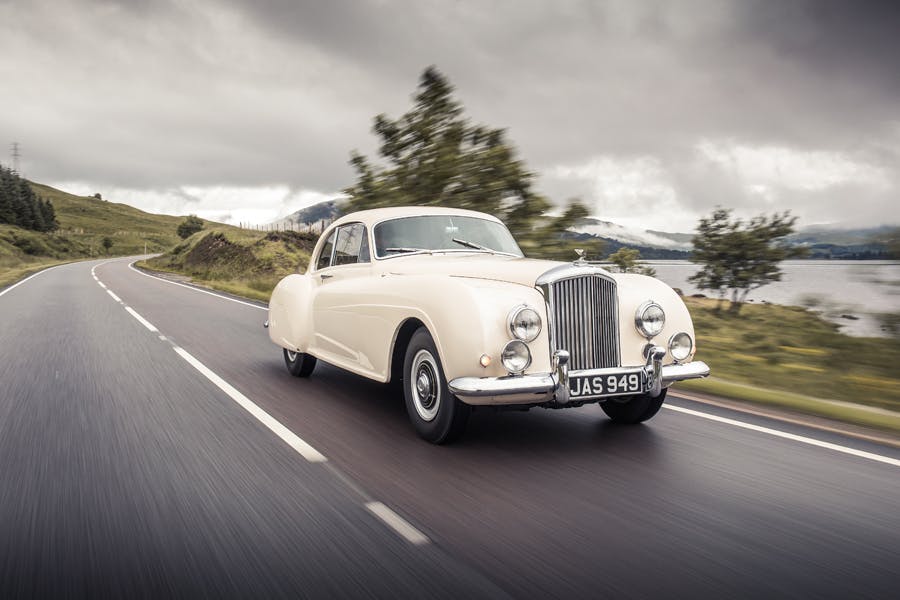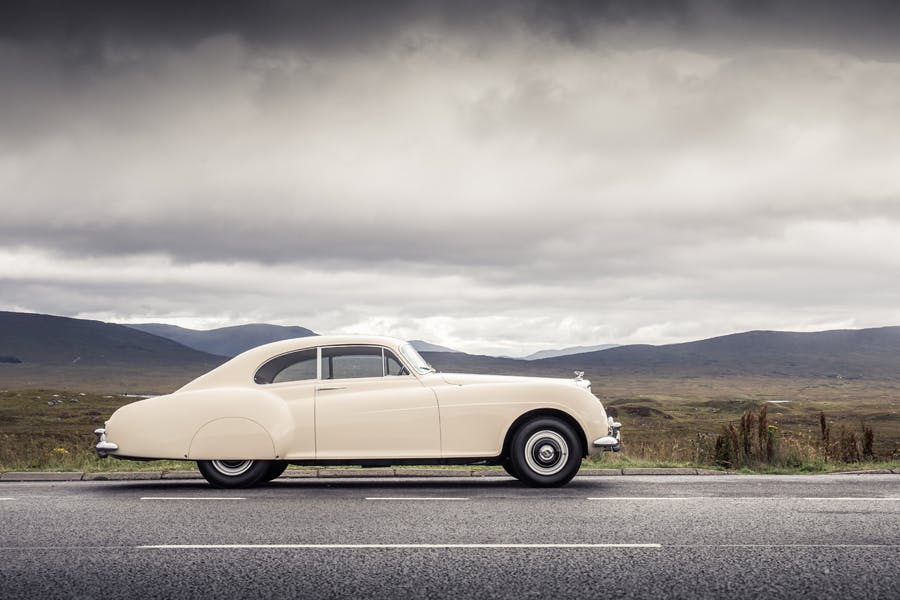An R-Type and Turbo R afternoon turns Berg into a Bentley boy
It’s only when we’ve safely returned to the Bentley Heritage garage that curator Mike Sayer happens to mention the value of the 1953 R-Type Continental that I’ve been slightly ham-fistedly driving through the country lanes around Crewe.
“It’s worth about £2.5 million ($2.9M),” he says. “I never tell people that before they drive it though.”
One of only 208 examples built during a short three-year run, it is perhaps the most beautiful Bentley ever made, so I probably shouldn’t be surprised at the R-Type’s valuation. But the sigh of relief at bringing it back in one piece is definitely deeper now.
I’ve been most conscious of not disturbing the John Blatchley-designed and HJ Mulliner coachbuilt bodywork. Hand-formed in aluminum, it blends an imperious presence with a sporting streamlining that made it the fastest four-seater luxury car in the world in its time. With a 115-mph top speed and 13.6 second 0-62 mph the R-Type was “a modern magic carpet which annihilates great distances,” according to The Autocar magazine.
Driving over pitted roads the R-Type’s suspension is completely unfazed, which is a little more than can be said of its driver. Although it’s over 206 inches long, it’s not a wide car by today’s standards, but even so, threading it through B-roads without the aid of wing mirrors to judge its position is a little nerve-wracking.
More challenging is the business of gear selection, however. The shifter for the four-speed manual transmission is down low on the driver’s door side and the lever is rather short, presumably to keep it out of the way when getting in and out. That means I have to awkwardly reach forward and down to change gears, almost nudging the steering wheel with my chin in the process. There’s no spring in the selector either so each shift is slow, long and tentative, and the clutch bites only in the top inch of travel. Oh, and there’s no synchromesh on first gear (crunch!). The 4.6 liter straight-six engine may make only 155 hp but there’s plenty of torque, so it will pull all day long in fourth gear.
Ensconced in at least a glade’s worth of walnut and a herd of rich maroon cowhide is a glorious way to travel. However, I suspect that photographer Alex Lawrence, lounging in the back seat, is rather more comfortable than I am—and that’s before Sayer tells me how much the car is worth.

Fast forward a decade and everything about the 1963 S3 is more familiar, starting with the car’s value. At “just” $140,000 it’s still pricey but not petrifying. There’s a four-speed GM automatic taking care of the gear changes and, up front, the 6.2-liter V-8 which would go on to become one of the longest-serving engines in the world.
In this first iteration it makes 218 horsepower, so despite the extra mass of its steel body it’s actually a little swifter than the R-Type. The extra performance is that bit more accessible too, with the grunt of two more cylinders and no fumbling about with gear selection.
In fact, I’d go as far as saying it’s easy. Delightfully so, with light steering, and brakes that have no trouble hauling two tons to standstill. It’s wonderfully smooth and refined with the V-8 barely audible and just a whisper of wind noise. No wonder Bentley wheels this car out often to chauffeur VIPs to and from the factory.

That’s a job that I’m actually qualified to do; back in the early Nineties I was dispatched by Auto Express magazine to complete a Rolls-Royce chauffeuring course. During the week-long training I was taught how to whisk passengers along A and B-roads without disturbing their drinks, how to apply the correct amount of force to close the doors without slamming them, and always to walk around the rear of the car so as not to be seen.
The immaculate Brooklands Green over tan 1991 Turbo R that I’m presented with next is just like the car that I did my training in. Back then I also got to throw this two tonnes of British beef around a skid pan. On over-inflated bald tires I remember being the only trainee to drift the complete circuit, before being advised that the objective was to minimize, not maximize the slide. Of course, with an additional three decades of maturity on both of us there’ll be none of that today.

In its day the Turbo R seemed imposingly large, but now far less so. It’s long, but no wider than an average modern SUV, and with thin pillars and plentiful glass the all-round visibility is better than any camera-equipped current car. You sit high up in soft Connolly leather armchairs in an acre of wood, embellished with brightly polished chrome. The wool carpets are so deep and rich it feels like one should wear slippers not outdoor shoes. The large, delightfully thin steering wheel is quite low, exaggerating the feeling of being command of grand vessel, not simply an automobile.
To select drive, you depress the button on the end of right column stalk and slip it down a notch. Apply the throttle and there’s a mild woofle from the engine bay followed by a great surge of forward momentum. This really is effortless performance, and it seems to be on call no matter the gear or speed.
On the road the steering is finger-light but still precise enough to position the car accurately. Using the Flying B as a kind of gunsight at the end of the great expanse of bonnet really helps, too. All the while the suspension simply soaks up everything the road happens to throw at you. Potholes, speed humps, you’ll barely notice them.
The mass of the Turbo R is rarely apparent, either. Even under heavy braking with the seriously-servoed brakes there’s not as much dive as you’d expect, while the roll-stiffness fettling (the R stands for Roadholding) means the chassis maintains cornering composure.
It’s no sports car, of course, but it is remarkable just how briskly this Bentley can cover ground. Also remarkable is the value that a Turbo R offers today. Recently bought for the Heritage Garage for £40,000 ($46,000) this one is very much at the top end of Turbo R prices. The Hagerty Valuation guide puts even #1 Concours cars at just $26,000 with #4 Fair Condition examples as low as $10,000.
For that price even I could afford to be a Bentley boy for more than just an afternoon.
[Maybe tally up those Lotus bills before getting ahead of yourself, ol’ bean. -EW]
Check out the Hagerty Media homepage so you don’t miss a single story, or better yet, bookmark it.








